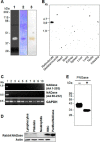Critical role for NAD glycohydrolase in regulation of erythropoiesis by hematopoietic stem cells through control of intracellular NAD content
- PMID: 24759100
- PMCID: PMC4047404
- DOI: 10.1074/jbc.M114.560359
Critical role for NAD glycohydrolase in regulation of erythropoiesis by hematopoietic stem cells through control of intracellular NAD content
Abstract
NAD glycohydrolases (NADases) catalyze the hydrolysis of NAD to ADP-ribose and nicotinamide. Although many members of the NADase family, including ADP-ribosyltransferases, have been cloned and characterized, the structure and function of NADases with pure hydrolytic activity remain to be elucidated. Here, we report the structural and functional characterization of a novel NADase from rabbit reticulocytes. The novel NADase is a glycosylated, glycosylphosphatidylinositol-anchored cell surface protein exclusively expressed in reticulocytes. shRNA-mediated knockdown of the NADase in bone marrow cells resulted in a reduction of erythroid colony formation and an increase in NAD level. Furthermore, treatment of bone marrow cells with NAD, nicotinamide, or nicotinamide riboside, which induce an increase in NAD content, resulted in a significant decrease in erythroid progenitors. These results indicate that the novel NADase may play a critical role in regulating erythropoiesis of hematopoietic stem cells by modulating intracellular NAD.
Keywords: CD38; Erythrocyte; Erythropoiesis; Hematopoietic Stem Cell; Intracellular NAD; NAD Glycohydrolase; Nicotinamide; Nicotinamide Adenine Dinucleotide (NAD); Reticulocytes.
© 2014 by The American Society for Biochemistry and Molecular Biology, Inc.
Figures


 ).
).







Similar articles
-
Regulation of NAD+ glycohydrolase activity by NAD(+)-dependent auto-ADP-ribosylation.Biochem J. 1996 Sep 15;318 ( Pt 3)(Pt 3):903-8. doi: 10.1042/bj3180903. Biochem J. 1996. PMID: 8836136 Free PMC article.
-
Vibrio fischeri genes hvnA and hvnB encode secreted NAD(+)-glycohydrolases.J Bacteriol. 2001 Jan;183(1):309-17. doi: 10.1128/JB.183.1.309-317.2001. J Bacteriol. 2001. PMID: 11114931 Free PMC article.
-
Molecular cloning and functional expression of bovine spleen ecto-NAD+ glycohydrolase: structural identity with human CD38.Biochem J. 2000 Jan 1;345 Pt 1(Pt 1):43-52. doi: 10.1042/bj3450043. Biochem J. 2000. PMID: 10600637 Free PMC article.
-
Characterization of mammalian ADP-ribosylation cycles.Biochimie. 1995;77(5):319-25. doi: 10.1016/0300-9084(96)88141-7. Biochimie. 1995. PMID: 8527484 Review.
-
Targeting NAD+ metabolism: dual roles in cancer treatment.Front Immunol. 2023 Dec 5;14:1269896. doi: 10.3389/fimmu.2023.1269896. eCollection 2023. Front Immunol. 2023. PMID: 38116009 Free PMC article. Review.
Cited by
-
Graft Source Choice.Adv Exp Med Biol. 2025;1475:57-75. doi: 10.1007/978-3-031-84988-6_4. Adv Exp Med Biol. 2025. PMID: 40488824 Review.
References
-
- Cho Y.-S., Han M.-K., Kwark O.-S., Phoe M. S., Cha Y.-S., An N.-H., Kim U.-H. (1998) Auto-ADP-ribosylation of NAD glycohydrolase from Neurospora crassa. Comp. Biochem. Physiol. B Biochem. Mol. Biol. 120, 175–181 - PubMed
-
- Kim U.-H., Kim M.-K., Kim J.-S., Han M.-K., Park B.-H., Kim H.-R. (1993) Purification and characterization of NAD glycohydrolase from rabbit erythrocytes. Arch. Biochem. Biophys. 305, 147–152 - PubMed
-
- Kim U.-H., Rockwood S. F., Kim H. R., Daynes R. A. (1988) Membrane-associated NAD+ glycohydrolase from rabbit erythrocytes is solubilized by phosphatidylinositol-specific phospholipase C. Biochim. Biophys. Acta 965, 76–81 - PubMed
-
- Okazaki I. J., Kim H.-J., McElvaney N. G., Lesma E., Moss J. (1996) Molecular Characterization of a glycosylphosphatidylinositol-linked ADP-ribosyltransferase from lymphocytes. Blood 88, 915–921 - PubMed
Publication types
MeSH terms
Substances
Associated data
- Actions
Grants and funding
LinkOut - more resources
Full Text Sources
Other Literature Sources
Medical
Research Materials

